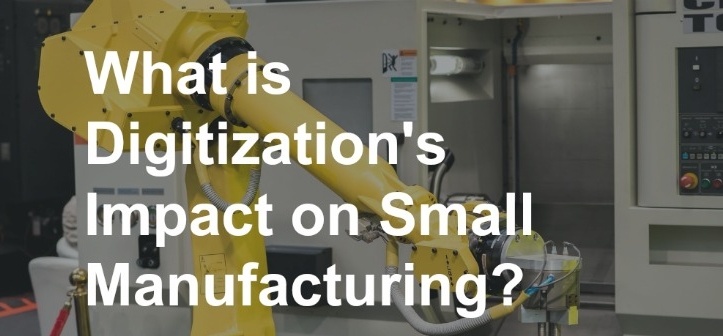March 31, 2017 | Manufacturing Technology, Smart Manufacturing
How Has Digitization Impacted Small to Medium-Sized Manufacturers Over the Last Decade?

When we talk about digitization in manufacturing, we are referring to the use of digital tools and technologies to create sustainable growth for manufacturers of all sizes. For example, tools such as mobile applications, video conferencing and instant messaging allow for easier communication while other digital technologies like robotics and data storage give small and medium-sized manufacturers the ability to compete in the global marketplace.
Over the past decade, digitization has become a major tool for growth in all sectors of the manufacturing industry. It has opened the door for greater productivity, efficiency and flexibility. Today, most manufacturers will agree that true gains in efficiency can only be achieved through the embrace and optimization of digital systems and processes throughout the entire production cycle.
So what is the impact of digitization on manufacturing and how has it shaped the industry over the past decade? Let’s look at a few of the biggest trends:
Boosting Performance
Manufacturers were early adopters of digital technologies throughout the 1990’s. Tools such as enterprise resource planning (ERP) – a business management software that allows companies to automate certain back office functions – allowed manufacturers of all sizes to boost their operational efficiency. These days, manufacturing companies outperform nearly all other industries in terms of operational efficiency thanks to digitization.
According to a recent report published by Capgemini Consulting:
“76% of the organizations have integrated technologies that enable employees to work and digitally cooperate from any location, which is a massive advantage for globally operating and decentralized companies.”
In another context, digital technologies and data analytics have been useful in giving manufacturers a clearer view of how raw materials and manufactured parts move through their system. This means that, over the past decade, the manufacturing industry has been able to cut costs and improve product quality by reducing energy consumption and scheduling factory operations in a much more efficient manner.
Linking All Phases of the Production Cycle
With data storage having grown cheaper and more flexible over the past decade, manufacturers have been able to gain new insights from large amounts of data using advanced analytics.
This, coupled with new advancements such as robotics and additive manufacturing, is giving companies the ability to digitally connect physical assets and allow data to flow across the entire value chain, linking every phase of the product cycle from design to use.
Increased Automation
In the United States, robotic implementation is being used to help human workers, rather than replace them. This phenomenon is being referred to as “cobotics” and is making it easier to manufacture complex parts in an efficient and safe manner. To date, the cobotics phenomenon has been mostly contained within the aerospace and automotive industries.
However, as developers create more sophisticated and adaptable robotic equipment, humans and machines will begin to collaborate in more skillful and efficient ways, expanding into other environments.
Creating Future Opportunities
So what impact will digitization have on the future of manufacturing? Today, 75% of manufacturing companies agree that digitization will give them a competitive advantage in the marketplace and create new business opportunities. Most of these companies expect that improvements will be focused on the bottom line, rather than the top line.
However, half of these companies do expect that digital technologies will help to improve their value proposition and their customer relations. With manufacturing being driven primarily by B2B interaction, this is an especially impressive sentiment.
75% of manufacturing companies agree that digitization will give them a competitive advantage in the marketplacePast and Future Impacts of Digitization
Being that manufacturers were early adopters of digital technologies, the effects of digitization can be seen more prominently in the manufacturing industry than perhaps any other.
By allowing manufacturers to trace materials, connect with remote workers, improve the flow of information and create new business opportunities, digital technologies have opened the door for unprecedented growth over the past decade and these trends look to be continuing.

